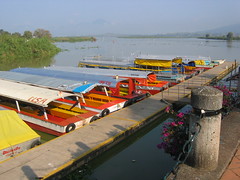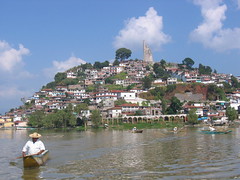
By David Agren
Some Institutional Revolutionary Party (PRI) members brandished white rubber bracelets with the slogan "¡Unidos Venceremos!" emblazoned around the circumference; a fashion statement similar to the previously popular Livestrong bands promoted by cyclist Lance Armstrong and worn by virtually every fresa kid in Guadalajara.
The bracelets faded in popularity over the past few months, becoming yesterday's style – not unlike PRI presidential candidate Roberto Madrazo's designs on Mexico's top job.
The former PRI party president finished third in a recent poll conducted for Grupo Reforma, garnering 21 percent support – well behind the National Action Party's (PAN) Felipe Calderon and the Democratic Revolutionary Party's (PRD) Andres Manuel Lopez Obrador. Even worse, 47 percent of respondents suspect Madrazo would abuse his power if elected; 38 percent viewed him as incompetent.
Not every Priista accepted the results; the PRI leadership challenged Grupo Reforma's methodology. Mario Rosales Anaya, a Guadalajara PRI booster, dismissed the results, saying, "Madrazo's going to get the momentum and climb in the polls."
He declined to explain how, but pointed out, "The PRI has the best national organization.
"We have support from all sectors of society."
Hampered by a rash of bad news, bitter internal bickering and last Monday's unfavorable poll, the PRI presidential campaign limped into Guadalajara Wednesday night. The momentum clearly elsewhere. Madrazo's sordid reputation for hardball politics and less than ethical campaigning preceded him.
In Tabasco state, he allegedly spent more than 50 times the legal limit in the 1995 governor's race, besting Lopez Obrador. Madrazo lost the last PRI primary for the national contest, but later became party president, perhaps the next best thing. As the PRI boss he ousted potential rivals, always conducting party business with an eye towards capturing the party's presidential nomination. Most infamously, he back stabbed the teachers' union president and PRI vice president Elba Esther Gordillo, branding her a traitor after she proposed working cooperatively with President Vicente Fox. In the PRI primary campaign, rival Arturo Montiel – the choice of an anti-Madrazo faction – accused Madrazo of leaking information that suggested Montiel and his family profited handsomely during Montiel's tenure as State of Mexico governor.
None of the past unpleasantness surfaced during the Guadalajara rally; an event attended by an eclectic mix of PRI faithful: businessmen in crisp suits, union members wearing T-shirts identifying their affiliations and even Huichol Indians in traditional white and pink costumes. In short, a cross-section of society, the PRI's traditional constituency. And most importantly for Madrazo, virtually all were loyalists anxious to catch of glimpse of their gallo (go-to guy). So many people showed up, late arrivals stood in the aisles after pushing past an overwhelmed security team, which had tried to keep them out of the hotel ballroom.
Not surprisingly, with such a friendly crowd in attendance, Madrazo delivered a vague message short on policy proposals. For the most part, he stated the obvious – lines like: "The PRI is a party that 100 percent wants Mexico to grow."
Or the equally generic, "There's no long term plan for the campo (countryside)."
He never detailed what exactly the PRI would offer the campo.
Madrazo spoke calmly, invoking little emotion from the crowd. The odd group of women would periodically interrupt the 45-minute speech, chanting campy support slogans like, "Roberto, amigo, (insert town name) es contigo (is with you)."
The candidate, an awkward grin on his face throughout the entire event, responded with clumsy waves, clenching a fist after fully extending his arm.
Perhaps offering a brief glimpse into his governing style – and confirming the fears expressed in the Grupo Reforma poll – he stated: "The public doesn't want change. … They want a strong president."
The Guadalajara event steered clear of controversy. Madrazo never mentioned his rivals from other parties or the poll directly, but conceded, "It's the most competitive contest in the history of the Republic."
As for party unity, he insisted, "Along with [former PRI presidential aspirants] Arturo Montiel and Everardo Moreno, together, we're going to win in 2006."
Supporters mobbed Madrazo after his speech; a cheesy pop track – a specially-made campaign theme song – looped endlessly. The party looked united – and some rabid partisans sported white wristbands to prove it.
From the Guadalajara Colony Reporter.




